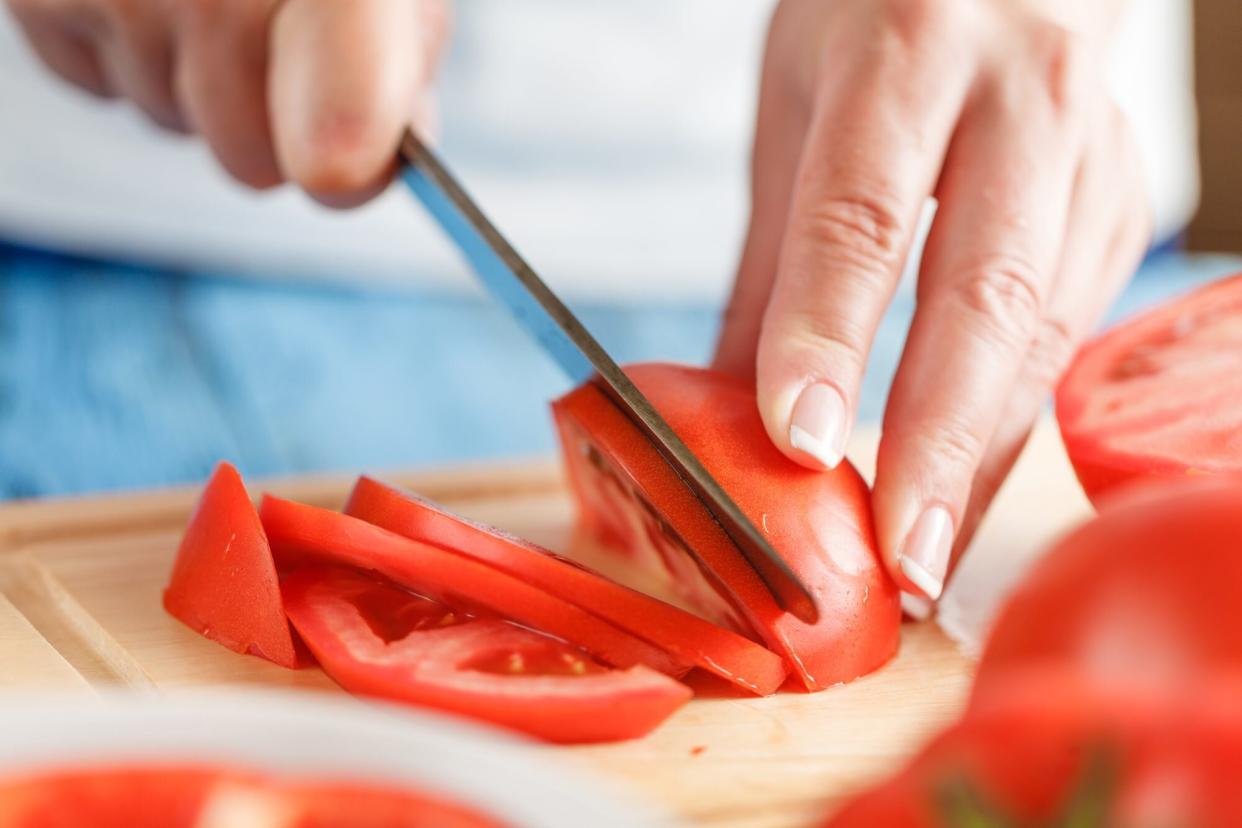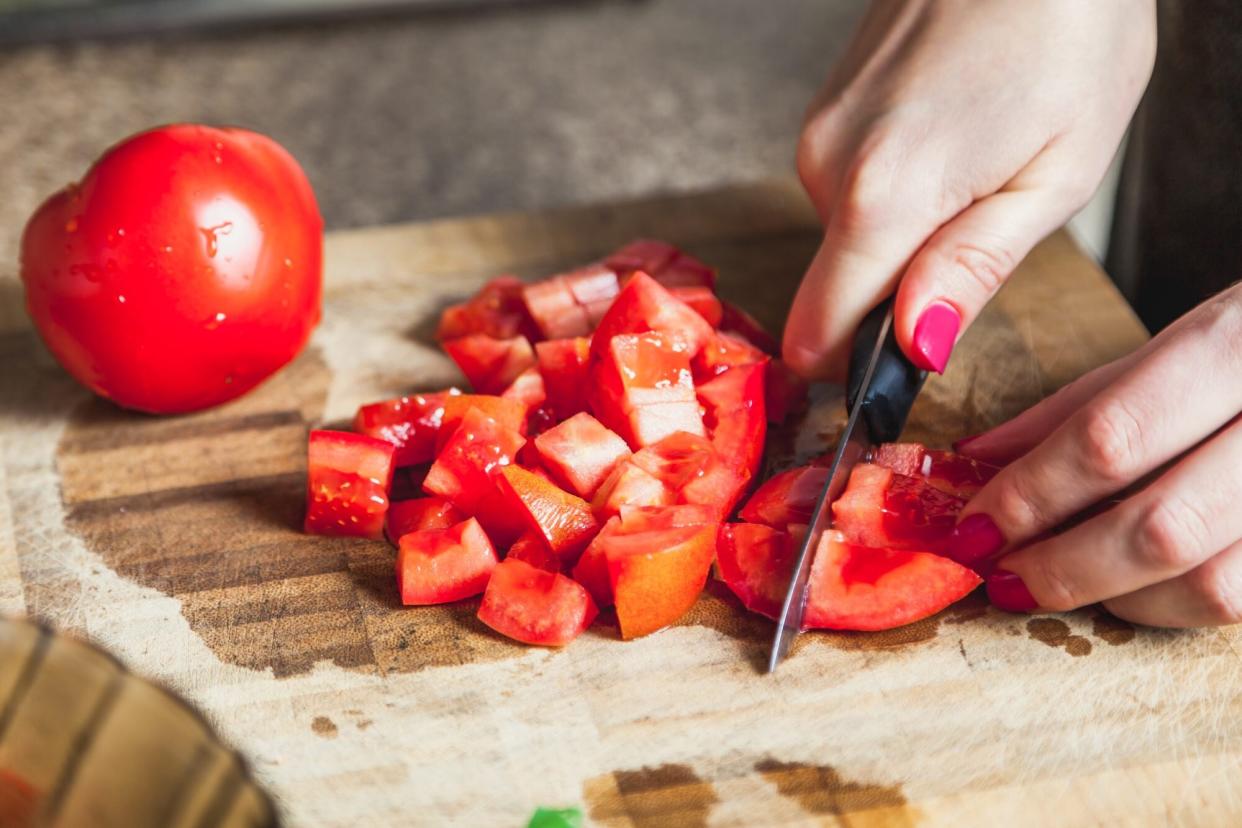From slicing to dicing: How to cut tomatoes the right way
Cutting up tomatoes is a common kitchen task—one that's easy if you use the correct technique and the right knife. Then, even the juiciest, ripest tomatoes will slice beautifully. Whether you are making perfect slices for Martha's favorite burgers, dicing tomatoes for Pico de Gallo, or preparing one of our Fresh Tomato Recipes, follow our methods for slicing (and dicing) tomatoes and cutting wedges. Plus, get our tips for how to cut tomatoes of various sizes, from tiny cherries to giant heirlooms.
Related: Should You Refrigerate Tomatoes
The Best Knife for Slicing Tomatoes
When you cut tomatoes, reach for a serrated knife. "The sharp teeth pierce and easily cut through the tomato skin," says recipe developer Lindsay Leopold.
While it might seem natural to reach for your chef's knife (which is suitable for most types of produce), this blade won't work on tomatoes. "Unless you're regularly sharpening your knives, the average chef's knife will not easily slice through a tomato due to the contrast between the taut skin and softer flesh," says Leopold. "Even a slightly dull knife will encounter resistance at the skin, which squishes and damages the flesh, squeezing out the seeds and juice."

sanapadh / GETTY IMAGES
What Size Knife?
For small- to medium-sized tomatoes like cocktail, Roma, or tomatoes on the vine, use a 6-inch utility knife with small, serrated teeth like the Shun 6-Inch Serrated Utility Knife, says Leopold. A larger 8-inch serrated knife, like a bread knife, works well for larger tomatoes, like beefsteak or heirloom. If you're in a pinch, you can turn to a sharp steak knife (especially one with finely serrated teeth).
Now that you have the right knife, you're ready to cut tomatoes. There are two methods to try, but the one you choose will depend on whether you're cutting wedges or slices—either can be used as is or turned into an easy dice.

Wang Yukun / GETTY IMAGES
How to Cut Tomato Wedges
If your goal is to cut tomato wedges (or if you want to remove the seeds and core before dicing the tomato), this is the method for you.
Prep the tomato: Start with a washed and dried tomato. Place the tomato stem side up on a cutting board. Remove the stem.
Halve the tomato: Hold it firmly, then use a gentle sawing motion through the center of the core to cut the tomato in half.
Core the tomato: Using the tip of your serrated knife or a paring knife, cut a "v" shape into the top of each tomato half to remove the core by the stem.
Cut wedges: Slice each tomato half into the desired amount of wedges. (If you are deseeding the tomato, cut into four wedges total.)
Coring or Dicing Wedges
Deseed and core the wedges: Place a wedge skin side down on your cutting board and run the knife along the flesh to cut out the seeds and core.
Dice the deseeded wedges: Slice each deseeded wedge into strips, then line the strips up and cut crosswise to create diced pieces.

AndreyCherkasov / GETTY IMAGES
How to Slice a Tomato
Slices are perfect for burgers, sandwiches, bagels, and some salads. They can also be easily turned into a dice if you are not planning to remove the core and seeds.
Prep the tomato: Start with a washed and dried tomato. Place the tomato stem side up on a cutting board.
Remove the stem and core using Leopold's culinary school method: "Put the tip of a paring knife into the tomato near its core at a 45-degree angle about a 1/2-inch deep (the point of the blade should then be underneath the core). Rotate the tomato so the paring knife cuts around the core in a complete circle. You should then be able to lift out the cone-shaped core," she says.
Slice the tomato: Place the tomato on one of its sides. Find the sweet spot where it can rest on its own, so it won't slip or slide when you cut it. Firmly hold the tomato and use a serrated knife to slice. Use a gentle sawing motion and make parallel slices.
Slice Horizontally, Not Vertically
This is a transformative tip for slicing. "Because of the anatomy of the tomato (the seed pockets grow vertically), you're going to get better slices by cutting the tomato around the 'equator' rather than vertically," says Leopold. "Cutting the tomato horizontally keeps the seeds evenly distributed to help the slices stay intact."

glebchik / GETTY IMAGES
Dicing After Slicing
To dice, make a small stack of the flat slices. Cut the stack into strips, then rotate the stack 90 degrees and cut crosswise into a dice. Do the same with each rounded end, but slice those separately so they don't slide.
Do You Need to Deseed?
You wouldn't remove the seeds from a tomato if you're slicing it for a sandwich—you want the juice and the seeds. So, when should you deseed a tomato? "It's a good idea to deseed a tomato if you're looking to avoid extra moisture or the texture or appearance of the seeds in the final dish," says Leopold. Otherwise, it's an additional step that isn't typically necessary for most recipes.
Cutting Small Tomatoes
Ignore online advice that says to slice small tomatoes, like cherry and grape tomatoes, between two plates or lids. "While this does work, it doesn't provide much control in cutting the tomatoes evenly in half," says Leopold. She opts for a less fussy technique: "I prefer to pinch the tomato between my thumb and pointer finger and slice through the center of each tomato between my fingers individually."
Cutting Heirloom Tomatoes
While conventional tomatoes are bred to withstand long-distance transportation, are picked underripe, and have tougher, firmer skin to prevent damage, heirloom tomatoes you find at farmers' markets are picked closer to ideal ripeness, says Leopold. As a result, they're juicier, more fragile, and easier to bruise—and more delicate to slice. Cut them the way you would other varieties (the methods hold, despite their unique shape) and definitely use that serrated knife. The riper the heirloom tomato, the more important the knife you use really is.






